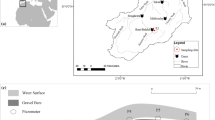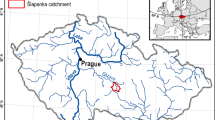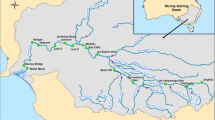Abstract
Very few studies have evaluated the role of the hyporheic zone (HZ) in aquatic ecosystem functioning or the factors driving hyporheic exchange flows on a large scale, especially in a semi-arid environment such as the Tafna watershed in Algeria. To understand this role through time and space, hydrogeochemical parameters, particularly nitrate concentrations (NO3–N), were measured monthly between February 2013 and April 2014 in surface water (SW), interstitial water (IW) and groundwater (GW) along a 170-km stretch from the river’s source to the outlet into the main stream of the Tafna River and its Isser and Chouly tributaries. The significant longitudinal evolution of NO3–N in the HZ was related to stream order and distance from the source. Moreover, the study indicated a significant difference between nitrate concentrations in the riffles (R) and pools (P) of the Tafna wadi. Principal component analysis (PCA) revealed the considerable impact of agriculture on nitrate concentrations. This study indicated on a large scale that nitrate-rich HZ contributed to increasing surface nitrate concentrations in upwelling sites and could be an important nitrate source for downstream SW, particularly during low-water (LW) periods when the Tafna can run dry on the surface. Thus, these results underline the importance of hyporheic zones functioning to the water quality of the watershed (process of enrichment and retention of nitrogen).





Similar content being viewed by others
References
Alexander RB, Smith RA, Schwarz GE (2000) Effect of stream channel size on the delivery of nitrogen to the Gulf of Mexico. Nature 403:758–761
Andreae N (1970) Nouveaux procédés de mesure en hydrologie. Edn Dunod Paris, Paris
Bardini L, Boano F, Cardenas MB, Revelli R, Ridolfi L (2012) Nutrient cycling in bedform induced hyporheic zones. Geochim Cosmochim Acta 84:47–61. https://doi.org/10.1016/j.gca.2012.01.025
Belaidi N, Taleb A, Gagneur J (2004) Composition and dynamics of hyporheic and surface fauna in a semi-arid stream in relation to the management of a polluted reservoir. Ann Lim 40:237–250
Birgand F, Skaggs RW, Chescheir GM, Gilliam JW (2007) Nitrogen removal in streams of agricultural catchments—a literature review. Crit Rev Environ Sci Technol 37:381–487
Boano F, Demaria A, Revelli R, Ridolfi L (2010) Biogeochemical zonation due to intrameander hyporheic flow. Water Resour Res 46: W02511. https://doi.org/10.1029/2008WR007583
Böhlke JK, Antweiler RC, Harvey JW, Laursen AE, Smith LK, Smith RL, Voytek MA (2009) Multi-scale measurements and modeling of denitrification in streams with varying flow and nitrate concentration in the upper Mississippi River basin. Biogeochemistry 93:117–141. https://doi.org/10.1007/s10533-008-9282-8
Bou C (1974) Les méthodes de récolte dans les eaux souterraines interstitielles. Ann Speleol 29:611–619
Bou C, Rouch R (1967) Un nouveau champ de recherche sur la faune aquatique souterraine. CR Acad Sc Paris 265:369–370
Boulton AJ, Scarsbrook MR, Quin JM, Burrell GP (1997) Land-use effects on the hyporheic ecology of five small streams near Hamilton, New Zealand. NZ J Mar Freshwat Res 31:609–622
Bretschko G, Leichtfried M (1987) The determination of organic matter in river sediments. Arch Hydrobiol Suppl 68:403–417
Bretschko G, Leichtfried M (1988) Distribution of organic matter and fauna in a second order alpine gravel stream (RITRODAT-Lunz). Verh Int Verein Limnol 23:1333–1339
Butturini A, Sabater F (2002) Nitrogen concentrations in a small Mediterranean stream: 1. Nitrate 2. Ammonium. Hydrol Earth Syst Sci 6(3):539–550
Campolo M, Andreussi P, Soldati A (2002) Water quality control in the river Arno. Wat Res 36:2673–2680
Canfield DE, Glazer AN, Falkowski PG (2010) The evolution and future of earth’s nitrogen cycle. Science 330:192–196
Caschetto M, Barbieri M, Galassi DMP et al (2014) Human alteration of groundwater–surface water interactions (Sagittario River, Central Italy): implication for flow regime, contaminant fate and invertebrate response. Environ Earth Sci 71:1791. doi.https://doi.org/10.1007/s12665-013-2584-8
Davies BE (1974) Loss on Ignition as an Estimate of Soil Organic Matter. Soil Science Society of America 38:150–151. https://doi.org/10.2136/sssaj1974.03615995003800010046x
Dent CL, Grimm NB, Fisher SG (2001) Multiscale effects of surface-subsurface exchange on stream water nutrient concentrations. J N Am Benthol Soc 20(2):162–181
Di Lorenzo T, Brilli M, Del Tosto D et al (2012) Nitrate source and fate at the catchment scale of the Vibrata River and aquifer (central Italy): an analysis by integrating component approaches and nitrogen isotopes. Environ Earth Sci 67:2383. doi.https://doi.org/10.1007/s12665-012-1685-0
Elwood JW, Newbold JD, O’Neill RV, Van Winkle W (1983) Resource spiraling: An operational paradigm for analyzing lotic ecosystems. In: Fontaine III TD, Bartell SM (ed) Dynamics of lotic ecosystems, Ann Arbor Sci, pp 3–27
Environment Agency (2009) The Hyporheic Handbook: A handbook on the groundwater–surface water interface and hyporheic zone for environment managers. Science report SC050070
Findlay S, Sobczak WV (1996) Variability in removal of dissolved organic carbon in hyporheic sediments. J N Am Benthol Soc 15:35–41
Findlay S, Strayer D, Goumbala C, Gould K (1993) Metabolism of streamwater dissolved organic carbon in the shallow hyporheic zone. Limnol Oceanogr 38:1493–1499
Fortner SL, White DS (1988) Interstitial water patterns: a factor influencing the distribution of some lotic aquatic vascular macrophytes. Aquat Bot 31:1–12
Gomez-Velez JD, Wilson JL, Cardenas MB (2012) Residence time distributions in sinuosity-driven hyporheic zones and their biogeochemical effects. Water Resour Res 48:W09533. https://doi.org/10.1029/2012WR012180
Gomez-Velez JD, Harvey JW, Cardenas MB, Kiel B (2015) Denitrification in the Mississippi River network controlled by flow through river bedforms. Nat Geosci 8(12):941–945. https://doi.org/10.1038/ngeo2567
Gooseff MN (2010) Defining hyporheic zones – advancing our conceptual and operational definitions of where stream water and groundwater meet. Geogr Compass 4:945–955
Grimm NB (1987) Nitrogen dynamics during succession in a desert stream. Ecology 68:1157–1170
Guardia P (1975) Géodynamique de la Marge Alpine du Continent Africain. D’après l’Etude de l’Oranie Nord Occidentale. Relations Structurales et Paléogéographiques Entre le Tell Extrème et L’avant Pays Atlassique + Carte au 1/100 000. These 3ème cycle. Université de Nice, Nice, p 285 (In French)
Harvey BN, Johnson ML, Kiernan JD, Green PG (2011) Net dissolved inorganic nitrogen production in hyporheic mesocosms with contrasting sediment size distributions. Hydrobiologia 658:343–352
Hendricks SP (1993) Microbial ecology of the hyporheic zone: a perspective integrating hydrology and biology. J N Am Benthol Soc 12:70–78
Hinkle SR, Duff JH, Triska FJ, Laenen A, Gates EB, Bencala KE, Wentz DA, Silva SR (2001) Linking hyporheic flow and nitrogen cycling near the Willametter River—a large river in Oregon, USA. J Hydrol 244:157–180
Jones JB, Holmes RM (1996) Surface-subsurface interactions in stream ecosystems. Trends Ecol Evol 11:239–242
Jones JB, Fisher SG, Grimm NB (1995) Vertical hydrological exchange and ecosystem metabolism in a Sonoran desert stream. Ecology 76:942–952
Jonnalagadda SB, Mhere G (2001) Water quality of the Odzi river in the eastern highlands of Zimbabwe. Wat Res 35:2371–2376
Kalinski ME (2011) Soil Mechanics: Lab Manual (2nd edn). John Wiley & Sons, INC
Lautz LK, Fanelli RM (2008) Seasonal biogeochemical hotspots in the streambed around restoration structures. Biogeochemistry 91:85–104. https://doi.org/10.1007/s10533-008-9235-2 doi
Lee DR, Cherry JA (1978) A field exercise on groundwater flow using seepage meters and mini-piezometers. J Geol Educ 27:6–10
Lefebvre S, Marmonier P, Pinay G (2004) Stream regulation and Nitrogen dynamics in sediment interstices: comparison of natural and straightened sectors of a third-order stream. River Res Appl 20:499–512
Lefebvre S, Marmonier P, Pinay G, Bour O, Aquilina L, Baudry J (2005) Nutrient dynamics in interstitial habitats of low-order rural streams with different bedrock geology. Arch Hydrobiol 164:169–191
Li XD, Liu CQ, Liu XL, Yu J, Liu XY (2014) Sources and processes affecting nitrate in a dam-controlled subtropical River, Southwest China. Aquat Geochem 20(5):483–500. https://doi.org/10.1007/s10498-014-9231-1
Malard F, Tockner K, Dole-Olivier MJ, Ward V (2002) A landscape perspective of surface-subsurface hydrological exchanges in river corridors. Freshw Biol 47:621–640
Marmonier P, Archambaud G, Belaidi N, Bougon N, Breil P, Chauvet E, Claret C, Cornut J, Datry T, Dole-Olivier MJ, Dumont B, Flipo N, Foulquier A, Ge´rino M, Guilpart A, Julien F, Maazouzi C, Martin D, Mermillod-Blondin F, Montuelle B, Namour PH, Navel S, Ombredane D, Pelte T, Piscart C, Pusch M, Stroffek S, Robertson A, Sanchez-Perez JM, Sauvage S, Taleb A, Wantzen M, Vervier P (2012) The role of organisms in hyporheic processes: gaps in current knowledge, needs for future research and applications. Ann Limnol 48:253–266
Mayewski PA, Lyons WB, Spencer MJ, Twickler M, Buck CF, Whitlow S (1990) An ice-core record of atmospheric response to anthropogenic sulphate and nitrate. Nature 378:355–359
McClain ME, Boyer EW, Dent CL, Gergel SE, Grimm NB, Groffman PM, Hart SC, Harvey JW, Johnston CA, Mayorga E, McDowell WH, Pinay G (2003) Biogeochemical hot spots and hot moments at the interface of terrestrial and aquatic ecosystems. Ecosystems 6(4):301–312. https://doi.org/10.1007/s10021-003-161-9
Meybeck M (1998) Man and river interface: Multiple impacts on water and particulates chemistry illustrated in the seine river watersheds. Hydrobiologia 374:1–20
Mulholland PJ, Marzolf ER, Webster JR, Hart DR, Hendricks SP (1997) Evidence of hyporheic retention of phosphorus in Walker Branch. Limnol Oceanogr 42:443–451
Mulholland PJ, Helton AM, Poole GC, Hall RO, Hamilton SK, Peterson BJ, Tank JL, Ashkenas LR, Cooper LW, Dahm CN, Dodds WK, Findlay SE, Gregory SV, Grimm NB, Johnson SL, McDowell WH, Meyer JL, Valett HM, Webster JR, Arango CP, Beaulieu JJ, Bernot MJ, Burgin AJ, Crenshaw CL, Johnson LT, Niederlehner BR, O’Brien JM, Potter JD, Sheibley RW, Sobota DJ, Thomas SM (2008) Stream denitrification across biomes and its response to anthropogenic nitrate loading. Nature 452:202–206. https://doi.org/10.1038/nature06686
National Agency of Hydrologic Resources (ANRH) (2012) Daily Data Flow in the Outlet of Tafna Catchment from 2000 to 2011. ANRH, Alger, Algeria
Rodier J (2009) L’Analyse de l’eau: eaux naturelles, eaux résiduaires, eau de mer, 9th edn. Dunod, Paris
Schlesinger WH (1997) Biogeochemistry: an analysis of global change. Academic Press, Cambridge
Smith JWN, Surridge BWJ, Haxton TH, Lerner DN (2009) Pollutant attenuation at the groundwater-surface water interface: a classification scheme and statistical analysis using national-scale nitrate data. J Hydrol 369:392–402
Stanford JA, Ward JV (1988) The hyporheic habitat of river ecosystem. Nature 335:64–66
Stelzer RS, Bartsch LA, Richardson WB, Strauss EA (2011) The dark side of the hyporheic zone: Depth profiles of nitrogen and its processing in stream sediments. Freshw Biol 56:2021–2033. https://doi.org/10.1111/j.1365-2427.2011.02632.x
Strahler AN (1957) Quantitative analysis of watershed geomorphology. Eos 38:912–920
Taleb A, Belaidi N, Sanchez-Perez JM, Vervier P, Sauvage S, Gagneur J (2008) The role of the hyporheic zone in the nitrogen dynamics within a semi-arid gravel bed stream located downstream of a heavily polluted reservoir (Tafna wadi, Algeria). River Res Appl 24:183–196
Thomas SA, Valett HM, Mulholland PJ, Fellows CS, Webster JR, Dahm CN, Peterson CG (2001) Nitrogen Retention in Headwater Streams: The Influence of Groundwater-Surface Water Exchange. In: Optimizing Nitrogen Management in Food and Energy Production and Environmental Protection: Proceedings of the 2nd International Nitrogen Conference on Science and Policy. The Scientific World 1(S2) 623–631 ISSN 1532–2246. https://doi.org/10.1100/tsw.2001.272
Triska FJ, Kennedy VC, Avanzino RJ, Zellweger GW, Bencala KE (1989) Retention and transport of nutrients in a third-order stream in northwestern California: hyporheic processes. Ecology 70:1893–1905
Vanek V (1997) Heterogeneity of groundwater/ surface water ecotones. In: Gibert J, Mathieu J, Fournier F (eds) Groundwater/ Surface Water Ecotones: biological And Hydrological Interactions And Management Options. Cambridge University Press, Cambridge, pp 151–161
Vannote RL, Minshall GW, Cummins KW, Sedell JR, Cushing CE (1980) The river continuum concept. Can J Fish Aquat Sci 37:130–137
Vervier P, Gibert J, Marmonier P, Dole-Olivier MJ (1992) Perspective on permeability of surface freshwater-groundwater ecotone. J N Am Benthol Soc 11:93–102
Vervier P, Bonvallet-Garey S, Sauvage S, Maurice V, Sanchez-Perez JM (2009) Influence of the hyporheic zone on the phosphorus dynamics of a large gravel bed river, Garonne river, France. Hydrol Process 23:1801–1812
Ward AS (2016) The evolution and state of interdisciplinary hyporheic research. WIREs Water 3:83–103. https://doi.org/10.1002/wat2.1120
Whelan MJ, Kirkby MJ, Burt TP (1995) Predicting nitrate concentration in small catchment streams. In: Trudgill ST (ed) Solute modelling in Catchment systems. Wiley, New York, pp 165–192
Xu S, Song J, Jiang W, Zhang G, Wen M, Zhang J, Xue Y (2017) Variability of darcian flux in the hyporheic zone at a natural channel bend. Water 9:170: 1–15. https://doi.org/10.3390/w9030170
Zarnetske JP, Haggerty R, Wondzell SM, Baker MA (2011) Dynamics of nitrate production and removal as a function of residence time in the hyporheic zone. J Geophys Res 116:G01025. https://doi.org/10.1029/2010JG001356
Zettam A, Taleb A, Sauvage S, Boithias L, Belaidi N, Sánchez-Pérez JM (2017) Modelling hydrology and sediment transport in a semi-arid and anthropized catchment using the SWAT model: the case of the Tafna River (Northwest Algeria). Water 9:216: 1–18. https://doi.org/10.3390/w9030216
Acknowledgements
We are particularly grateful to Said Belhadjar for his efforts during the sampling campaigns, to the laboratory of the Regional Institute of Veterinary Medicine (Tlemcen) and its personnel for their help with laboratory analysis, and to Amine Zettam for producing the ArcMap figures. We also thank Claire Tarring for making improvements to the English text.
Author information
Authors and Affiliations
Corresponding author
Rights and permissions
About this article
Cite this article
Haddou, K., Bendaoud, A., Belaidi, N. et al. A large-scale study of hyporheic nitrate dynamics in a semi-arid catchment, the Tafna River, in Northwest Algeria. Environ Earth Sci 77, 520 (2018). https://doi.org/10.1007/s12665-018-7673-2
Received:
Accepted:
Published:
DOI: https://doi.org/10.1007/s12665-018-7673-2




